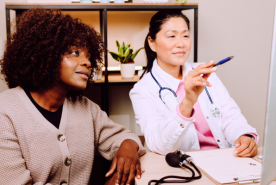Contrast dye is used in tests like MRIs and CT scans and can affect kidneys. Learn about the different types and what people with kidney disease need to know to be safe for imaging tests.
About Contrast Dye
Contrast dye is a special liquid used during some imaging tests, like an MRI or CT scan. It helps make parts of your body show up more clearly in pictures. This makes the pictures easier to interpret and can help healthcare professionals with diagnosis and treatment decisions.
If you have chronic kidney disease (CKD) or a kidney transplant, you may wonder how contrast dye might affect your kidneys. For most people, contrast dye can be used safely with the right planning. But sometimes these dyes can lead to kidney problems or cause problems in people who already have kidney disease.
Uses
Contrast dye is used during imaging tests. The dye helps add detail to pictures of your kidneys or other parts of your body. These pictures can help your healthcare professional find changes in the shape or structure of your kidneys, blockages, kidney stones, kidney cancer, or problems with blood vessels.
Some examples of these imaging tests include:
- CT scan – uses X-rays and computer technology, often just a few minutes
- MRI scan – uses strong magnets and radio waves, a longer process (often 20-90 minutes)
- Ultrasound – uses sound waves to get a general picture (less detailed than the other two tests)
Not every imaging test needs contrast dye. Sometimes a non-contrast scan or another kind of imaging test can give enough information.
How it works
Before the imaging test, contrast dye is injected into your vein with a needle (also known as intravenous or IV). The dye travels through your blood until it reaches the part of your body where the pictures are needed. The dye helps “light up” the parts of your body in the picture so it is easier to see what is happening. The dye is not permanent - over time, it leaves your body through your kidneys and into your urine (pee).
Types
Not all contrast dyes are the same. Each one has different ingredients, uses, and risks. Some of the most common types of contrast dye include:
- Iodinated contrast products – used with CT scans, these products contain iodine
- Gadolinium – used with MRIs, this dye contains a special type of metal
- Ultrasound microbubbles – used with ultrasound to highlight blood flow
- Barium – used for pictures of your digestive system (esophagus, stomach, intestines, and colon). This dye is swallowed or given by enema and stays in your gut (does not go into your blood)
Your healthcare professional will only suggest contrast if it makes a real difference in the test results and helps answer the clinical question.
Safety
How safe contrast dye is for you depends on many factors - your estimated glomerular filtration rate (eGFR), your other health conditions, the type of dye, and the type of imaging test. Below are some important points for people with kidney disease to consider:
Estimated glomerular filtration rate (eGFR)
- CT scans with iodinated contrast – this type of contrast dye can cause acute kidney injury (AKI). Another name for this specific type of AKI is “contrast-associated acute kidney injury” or CA-AKI. The risk for most people is low, but it can be higher if you have advanced CKD, diabetes, dehydration (not drinking enough water), or are very sick. To lower your risk, your healthcare professional may check your eGFR before your CT scan and give you extra fluids through your vein (IV) before and after the procedure.
- MRI scans with gadolinium - the overall risk to your kidneys is very low when newer, safer forms are used (also known as “ACR group 2 or 3 agents”). Your healthcare professional will choose the safest option based on your eGFR.
- Barium and ultrasound microbubbles – are not likely to affect your kidneys
Allergic reactions
- Mild reactions (warm feeling, flushing, itching, rash) can happen. Severe reactions are rare but still possible. Tell your healthcare team if you have ever had a reaction to contrast dye before, or if you have asthma or other serious allergies.
Medications
- Some medicines may need to be stopped before an imaging test. Examples include metformin, non-steroidal anti-inflammatory drugs (NSAIDs) such as ibuprofen or naproxen, diuretics (water pills), and some antibiotics. Talk with your healthcare team about whether you need to hold (temporarily stop taking) any medicines and if so, when you should restart them.
Share the names of ALL the medicines, vitamins, and supplements you are taking with your healthcare team before your imaging test to help avoid interactions or testing delays.
Dialysis or transplant
- If you are on dialysis, your kidney and radiology (imaging) teams will work together to plan the best timing for giving you the contrast dye and completing the testing.
- If you have a kidney transplant, contrast dye can often be used safely with careful planning, labs, and healthy hydration.
Hydration
- Drinking enough water before and after the imaging test is one of the most helpful steps to protect your kidneys (unless your healthcare professional has told you to limit fluids for heart failure or other reasons). To help you stay hydrated, your healthcare professional may give you IV fluids before and/or after your test.
Balancing the safety and effectiveness of contrast dye is important. While it may be safer to use a test without contrast dye, sometimes contrast dye makes a very big difference with diagnosis and treatment decisions. Plus, there can also be harm from needing to do repeat testing if the first test is not clear. Talk with your healthcare team about your risks and benefits!
Questions for your healthcare team
Do I need contrast dye for this imaging test, or can a non-contrast study answer the question?
In some cases, contrast dye may not provide much more benefit compared to doing the test without the dye. Having this conversation with your healthcare professional can help you learn about the risks and benefits to you with either testing approach.
What is my level of risk for kidney problems from the contrast dye you plan on using?
Everyone has a different level of risk that depends on many factors. Having this conversation with your healthcare team can help you understand your level of risk and steps you can take to lower your risk.
What is the plan if I have had a negative reaction to contrast dye before?
Having a negative reaction to contrast dye in the past does not always mean it will happen again. Your healthcare professional may recommend using other medicines like steroids and/or antihistamines right before the dye is given to lower the risk (often called “pre-medicating”). Starting this conversation with your healthcare team early can help you better understand your level of risk and the steps you can take to lower your risk this time.
Should I stop or change any medicines/supplements before or after the imaging test?
Some medicines can interact with contrast dye and increase your risk of kidney problems. Talk with your healthcare professional about your medication regimen. If anything needs to be held (temporarily stopped), make sure you fully understand exactly when to stop the medicine(s) and when it is safe to restart. It can be hard to remember instructions during stressful times or health scares. So, ask for the instructions in writing to help you remember.
[For people on dialysis] How will you plan this imaging test around my dialysis treatments?
Most contrast dyes are removed from your body by the kidneys. So, if you are on dialysis, your imaging test will need to be scheduled around your dialysis treatments to make sure the dye doesn’t stay in your body for too long.








